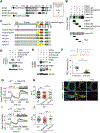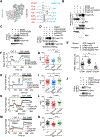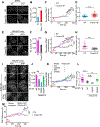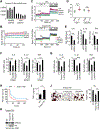Tmem178 negatively regulates store-operated calcium entry in myeloid cells via association with STIM1
- PMID: 31018906
- PMCID: PMC7102427
- DOI: 10.1016/j.jaut.2019.04.015
Tmem178 negatively regulates store-operated calcium entry in myeloid cells via association with STIM1
Abstract
Store-operated calcium entry (SOCE) modulates cytosolic calcium in multiple cells. Endoplasmic reticulum (ER)-localized STIM1 and plasma membrane (PM)-localized ORAI1 are two main components of SOCE. STIM1:ORAI1 association requires STIM1 oligomerization, its re-distribution to ER-PM junctions, and puncta formation. However, little is known about the negative regulation of these steps to prevent calcium overload. Here, we identified Tmem178 as a negative modulator of STIM1 puncta formation in myeloid cells. Using site-directed mutagenesis, co-immunoprecipitation assays and FRET imaging, we determined that Tmem178:STIM1 association occurs via their transmembrane motifs. Mutants that increase Tmem178:STIM1 association reduce STIM1 puncta formation, SOCE activation, impair inflammatory cytokine production in macrophages and osteoclastogenesis. Mutants that reduce Tmem178:STIM1 association reverse these effects. Furthermore, exposure to plasma from arthritic patients decreases Tmem178 expression, enhances SOCE activation and cytoplasmic calcium. In conclusion, Tmem178 modulates the rate-limiting step of STIM1 puncta formation and therefore controls SOCE in inflammatory conditions.
Keywords: Macrophage activation; Osteoclastogenesis; SOCE; STIM1; Tmem178.
Copyright © 2019. Published by Elsevier Ltd.
Conflict of interest statement
Declare of interests
The authors declare that they have no conflicts of interest with the contents of this article.
Figures






Similar articles
-
STIM1 Phosphorylation at Y361 Recruits Orai1 to STIM1 Puncta and Induces Ca2+ Entry.Sci Rep. 2017 Feb 20;7:42758. doi: 10.1038/srep42758. Sci Rep. 2017. PMID: 28218251 Free PMC article.
-
Filamin A Modulates Store-Operated Ca2+ Entry by Regulating STIM1 (Stromal Interaction Molecule 1)-Orai1 Association in Human Platelets.Arterioscler Thromb Vasc Biol. 2018 Feb;38(2):386-397. doi: 10.1161/ATVBAHA.117.310139. Epub 2017 Dec 28. Arterioscler Thromb Vasc Biol. 2018. PMID: 29284605
-
Interplay between ER Ca2+ Binding Proteins, STIM1 and STIM2, Is Required for Store-Operated Ca2+ Entry.Int J Mol Sci. 2018 May 19;19(5):1522. doi: 10.3390/ijms19051522. Int J Mol Sci. 2018. PMID: 29783744 Free PMC article.
-
Key components of store-operated Ca2+ entry in non-excitable cells.J Pharmacol Sci. 2014;125(4):340-6. doi: 10.1254/jphs.14r06cp. Epub 2014 Jul 17. J Pharmacol Sci. 2014. PMID: 25030742 Review.
-
STIM1 and lipid interactions at ER-PM contact sites.Am J Physiol Cell Physiol. 2025 Jan 1;328(1):C107-C114. doi: 10.1152/ajpcell.00634.2024. Epub 2024 Dec 2. Am J Physiol Cell Physiol. 2025. PMID: 39620863 Free PMC article. Review.
Cited by
-
The tethering function of mitofusin2 controls osteoclast differentiation by modulating the Ca2+-NFATc1 axis.J Biol Chem. 2020 May 8;295(19):6629-6640. doi: 10.1074/jbc.RA119.012023. Epub 2020 Mar 12. J Biol Chem. 2020. PMID: 32165499 Free PMC article.
-
Proteins Interacting with STIM1 and Store-Operated Ca2+ Entry.Prog Mol Subcell Biol. 2021;59:51-97. doi: 10.1007/978-3-030-67696-4_4. Prog Mol Subcell Biol. 2021. PMID: 34050862 Review.
-
NLRP3 inflammasome is regulated in osteoclasts through a Tmem178-dependent mechanism that restricts calcium influx.bioRxiv [Preprint]. 2025 Jul 31:2025.07.28.667255. doi: 10.1101/2025.07.28.667255. bioRxiv. 2025. PMID: 40766650 Free PMC article. Preprint.
-
Tmem178 Negatively Regulates IL-1β Production Through Inhibition of the NLRP3 Inflammasome.Arthritis Rheumatol. 2024 Jan;76(1):107-118. doi: 10.1002/art.42666. Epub 2023 Nov 13. Arthritis Rheumatol. 2024. PMID: 37534578 Free PMC article.
-
Extracellular cysteines C226 and C232 mediate hydrogen sulfide-dependent inhibition of Orai3-mediated store-operated calcium entry.Am J Physiol Cell Physiol. 2022 Jan 1;322(1):C38-C48. doi: 10.1152/ajpcell.00490.2019. Epub 2021 Nov 17. Am J Physiol Cell Physiol. 2022. PMID: 34788146 Free PMC article.
References
-
- Berridge MJ, Bootman MD, Roderick HL, Calcium signalling: dynamics, homeostasis and remodelling, Nat. Rev. Mol. Cell Biol 4 (2003) 517–529. - PubMed
-
- Berridge MJ, The inositol trisphosphate/calcium signaling pathway in health and disease, Physiol. Rev 96 (2016) 1261–1296. - PubMed
-
- Feske S, Calcium signalling in lymphocyte activation and disease, Nat. Rev. Immunol 7 (2007) 690–702. - PubMed
Publication types
MeSH terms
Substances
Grants and funding
LinkOut - more resources
Full Text Sources
Molecular Biology Databases

